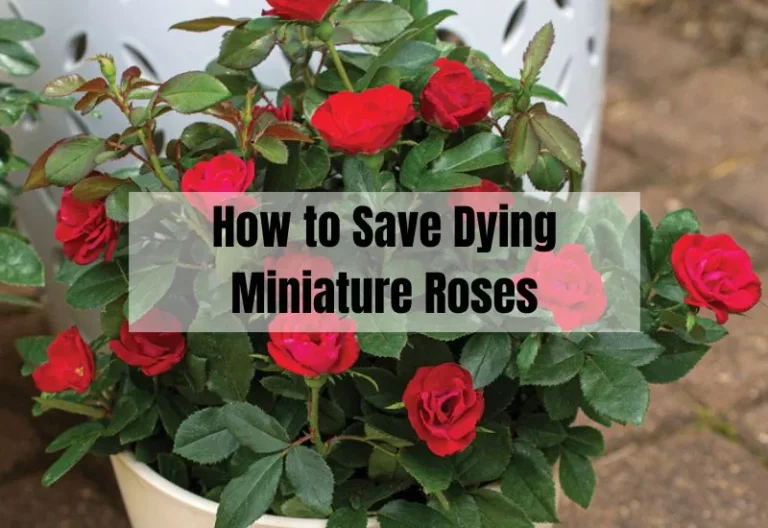How to Keep Miniature Roses Alive: A Comprehensive Guide
Get ready to be swept away by the beauty and fragrance of miniature roses! These stunning plants are the perfect addition to any garden or indoor space, and their hardy nature means they can thrive in a variety of climates.
But don’t be fooled by their delicate appearance – miniature roses require specific care to truly flourish. In this blog post, we’ll reveal the essential tips and tricks you need to keep your miniature roses alive and thriving.
So, whether you’re a seasoned gardener or a beginner, get ready to elevate your rose game to the next level with our expert advice.

How to Keep Miniature Roses Alive
Locate Your Mini Rose Bush Where it Will Receive Plenty of Sunlight
Miniature roses need plenty of sunlight to thrive, just like their full-sized counterparts. For outdoor miniature roses, choose a spot where they will receive full sun. Indoor miniature roses should be placed on a south or west-facing window where they will be exposed to at least five hours of direct sunlight.
If your miniature rose is in a container, make sure to turn it once a week so that all sides of the plant receive sunlight. If your plant doesn’t receive enough sunlight, it will become spindly and weak.
Keep your Rose Nice and Warm, but Not Too Hot
Although miniature roses can tolerate temperature extremes, they grow best in mild daytime temperatures of around 70 degrees Fahrenheit and 60 degrees Fahrenheit at night.
Sustained temperatures below 50 degrees Fahrenheit cause the plant to stop flowering. Make sure to keep your miniature rose in a place where the temperature is consistent and doesn’t fluctuate too much.
Water Frequently Enough so that the Soil is Moist, but Not Soggy
Miniature roses have shallow roots and need to be watered more often than standard rose bushes. Make sure to water your plant frequently enough so that the soil is moist, but not soggy. Overly wet soil, especially in container-grown miniature roses, can cause root rot or other fungi problems.
Wait until the top inch or so of the soil is dry, and then water generously. If your miniature rose is in a container, make sure the water drains easily through holes in the bottom of the container.
Fertilize your Miniature Roses
starting in the spring, and every three weeks after that until August
To keep your miniature roses healthy and blooming, fertilize them regularly. Use a balanced fertilizer and apply according to the directions as per the size and age of your miniature rose bush.
Start fertilizing in the spring and continue every three weeks until August, which is when roses start to go dormant. Fertilizing your plant too much or too little can affect its growth and health.
Deadhead Spent Blooms
Deadheading, or plucking off, spent blooms encourages the plant to produce more blossoms. Always use sterilized scissors or anvil pruners.
Dip your cutting tools into a household cleaner, such as Pine-Sol, between cuts and allow them to air dry. This will prevent the spread of disease and keep your plant healthy.
Prune your Rose During the Dormant Season
Although it may seem counter-intuitive to cut back a growing plant, pruning actually creates a healthier rosebush that will bloom more profusely. Wait until the end of winter or early spring, and then cut away any dead, dying, or broken branches.
Prune healthy branches back to just above a five-leaflet leaf. Pruning your miniature rose will help maintain its shape and encourage new growth.
How to Care for Miniature Roses Grown Indoors
Provide Adequate Sunlight
Indoor miniature roses need adequate sunlight to grow and bloom. Place your miniature rose on a south or west-facing window where it will receive at least five hours of direct sunlight. If your plant doesn’t receive enough sunlight, use grow lights to supplement it.
Maintain a Consistent Temperature
Miniature roses grown indoors need a consistent temperature between 60-70 degrees Fahrenheit.
Avoid exposing the plant to temperature extremes or drafts, which can cause stress and damage to the plant.
Control Humidity Levels
Indoor environments are often dry, which can be harmful to miniature roses. Use a humidifier to increase the humidity around your plant.
Alternatively, you can group your miniature roses together to create a microclimate with higher humidity. This will help your plant stay healthy and prevent problems such as spider mites.
Avoid Overwatering
Overwatering can be a problem for indoor miniature roses, just like outdoor ones. Make sure to water your plant frequently enough so that the soil is moist, but not soggy.
Check the top inch or so of the soil and water when it feels dry. If the soil is too wet, it can cause root rot or other fungi problems.
Watch for Spider Mites
Spider mites are a common problem for indoor miniature roses. These tiny pests can cause damage to the leaves and flowers of your plant. To prevent an infestation, watch your plant carefully for the signs of spider mites, such as tiny webs or speckling on the leaves. If you notice an infestation, spray your plant with an insecticide according to the directions on the label.
How to Provide Adequate Sunlight for Miniature Roses Indoors
Place Miniature Roses on a South or West-facing Window
Indoor miniature roses need plenty of sunlight to grow and bloom. Place your miniature rose on a south or west-facing window where it will receive at least five hours of direct sunlight. If your plant doesn’t receive enough sunlight, use grow lights to supplement it.
Use Grow Lights if Necessary
If your miniature rose doesn’t receive enough sunlight, use grow lights to supplement it. LED grow lights are a good choice for indoor plants because they don’t generate heat and use less energy than traditional bulbs.
How to Maintain a Consistent Temperature for Miniature Roses Indoors
- Keep the room temperature between 60-70 degrees Fahrenheit
Miniature roses grown indoors need a consistent temperature between 60-70 degrees Fahrenheit. Avoid exposing the plant to temperature extremes or drafts, which can cause stress and damage to the plant.
- Avoid exposing the plant to temperature extremes
Indoor miniature roses are sensitive to temperature extremes. Keep your plant away from drafts or areas with fluctuating temperatures, such as near air conditioning vents or heaters.
How to Control Humidity Levels for Miniature Roses Indoors
- Use a humidifier in dry indoor environments
Indoor environments are often dry, which can be harmful to miniature roses. Use a humidifier to increase the humidity around your plant. This will help your plant stay healthy and prevent problems such as spider mites.
- Group plants together to create a microclimate with higher humidity
Alternatively, you can group your miniature roses together to create a microclimate with higher humidity. This will help your plant stay healthy and prevent problems such as spider mites.
Frequently Asked Questions (FAQs)
How often should I water my miniature roses?
Water frequently enough so that the soil is moist, but not soggy. Wait until the top inch or so of the soil is dry, and then water generously.
How do I fertilize my miniature roses?
Use a balanced fertilizer and apply according to the directions as per the size and age of your miniature rose bush.
How do I prune my miniature rose?
Wait until the end of winter or early spring, and then cut away any dead, dying, or broken branches. Prune healthy branches back to just above a five-leaflet leaf.
How do I deal with spider mites?
Watch your plant carefully for the signs of spider mites, such as tiny webs or speckling on the leaves. If you notice an infestation, spray your plant with an insecticide according to the directions on the label.i
Conclusion
Congratulations! Now you know how to keep your miniature roses alive and thriving. These beautiful and fragrant plants can bring joy to any garden or indoor space, but they do require specific care to stay healthy.
Remember to provide adequate sunlight, maintain a consistent temperature, water and fertilize correctly, deadhead spent blooms, prune during the dormant season, and watch for pests. If you’re growing miniature roses indoors, make sure to control humidity levels and avoid overwatering. With these tips and tricks, you can enjoy your miniature roses for years to come.
Thanks for reading! I hope you found this guide helpful. If you have any questions or comments, feel free to leave them below. Happy gardening!
Related Posts:
- Understanding the Toxicity of Miniature Roses to Cats
- The Ultimate Guide for Growing Miniature Roses Outdoors
- Revive Your Miniature Roses: How to Rescue Them from the Brink of Death
- Unlocking the Secrets of Rose Gardening: Coffee Grounds and Eggshells
- A Deep Dive into the Safety of Rose Petals in a Rat’s Diet






